Abstract
The influenza A/Alaska/77 (H3N2) virus mutant 143-1 is temperature sensitive (ts) due to a spontaneous in-frame 36-nucleotide deletion in the nonstructural (NS) gene segment, which leads to a 12-amino-acid deletion in the NS1 protein. In addition, it has a small-plaque phenotype on MDCK cell monolayers. However, phenotypically revertant (i.e., ts+) viruses were isolated readily following replication of the 143-1 virus both in vitro and in vivo. In order to determine the genetic mechanism by which escape from the ts phenotype occurred, we performed segregational analysis and found that an intrasegmental suppressor mutation caused the loss of the ts phenotype. Nucleotide sequence analysis revealed the presence of an intragenic mutation in each of the ts+ phenotypic revertant viruses, involving a substitution of valine for alanine at amino acid 23 of the NS1 protein. This mutation resulted in acquisition of the ts+ phenotype and also in the large-plaque phenotype on MDCK cells, characteristic of the wild-type A/Alaska/77 parent virus. This amino acid substitution is predicted to generate an area of alpha helix in the secondary structure of the amino-terminal portion of the NS1 protein of the revertant viruses which may compensate for loss of an alpha-helical region due to the deletion of amino acids 66 to 77 in the NS1 protein of the 143-1 virus.
Full text
PDF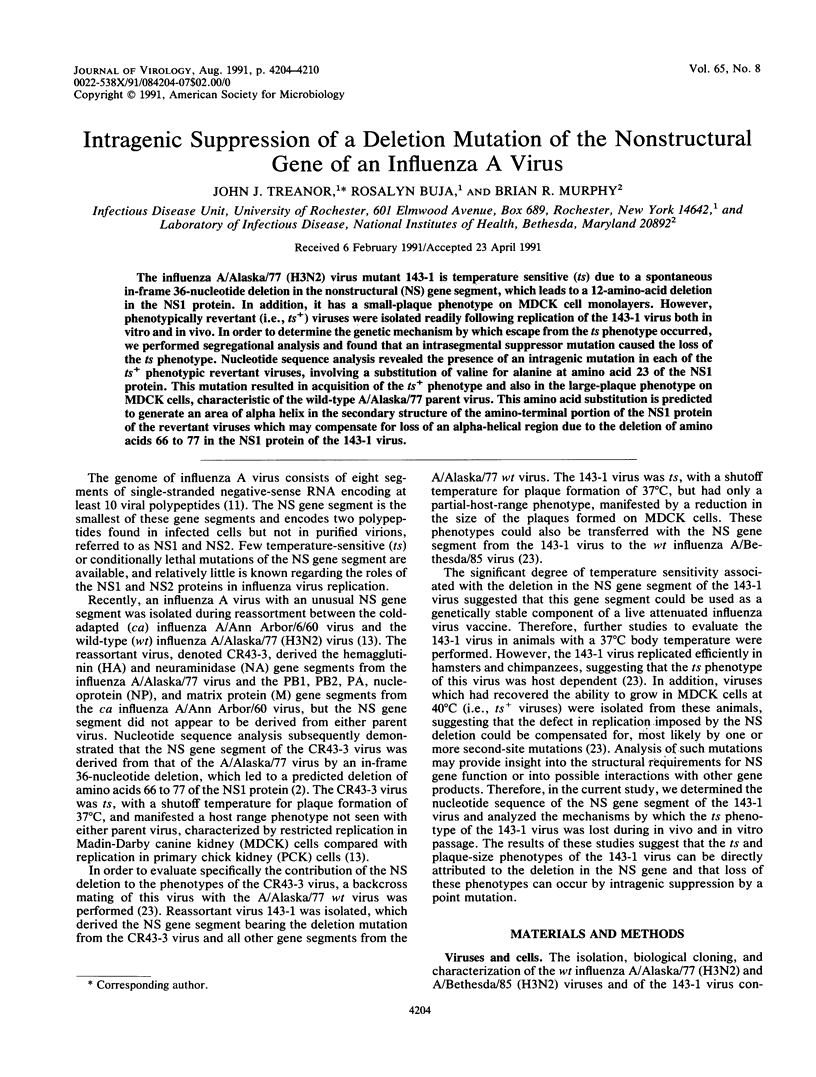
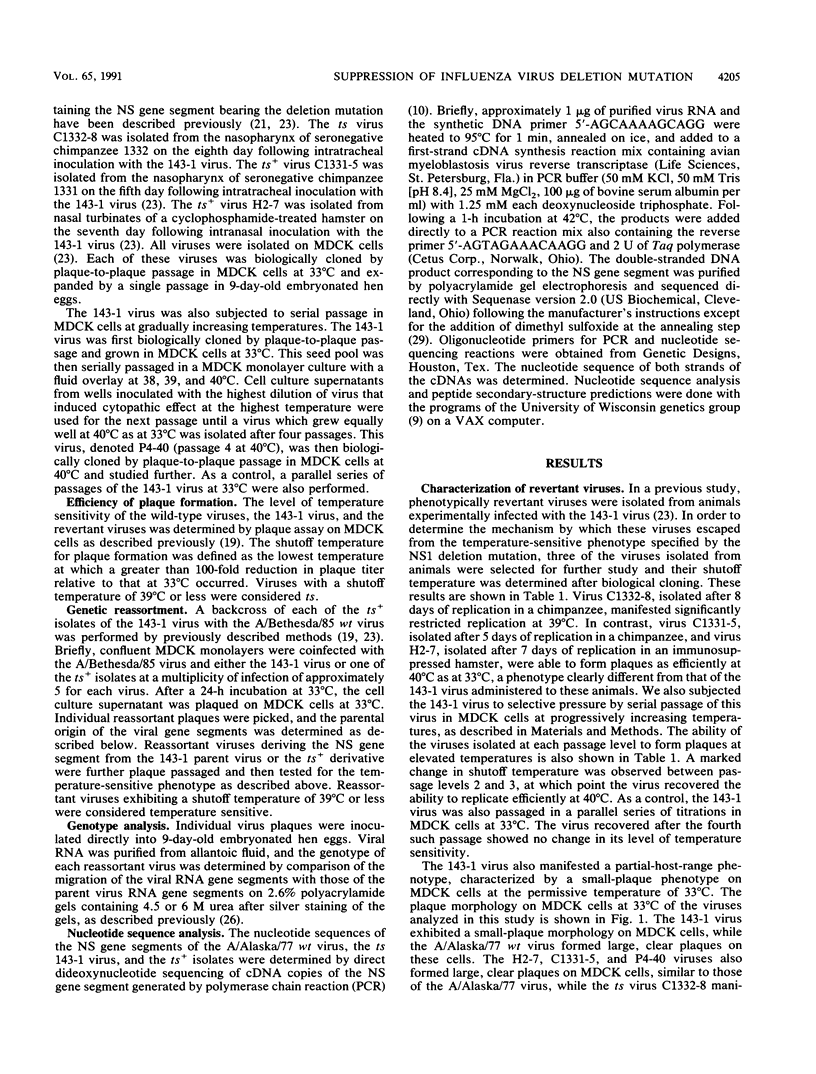
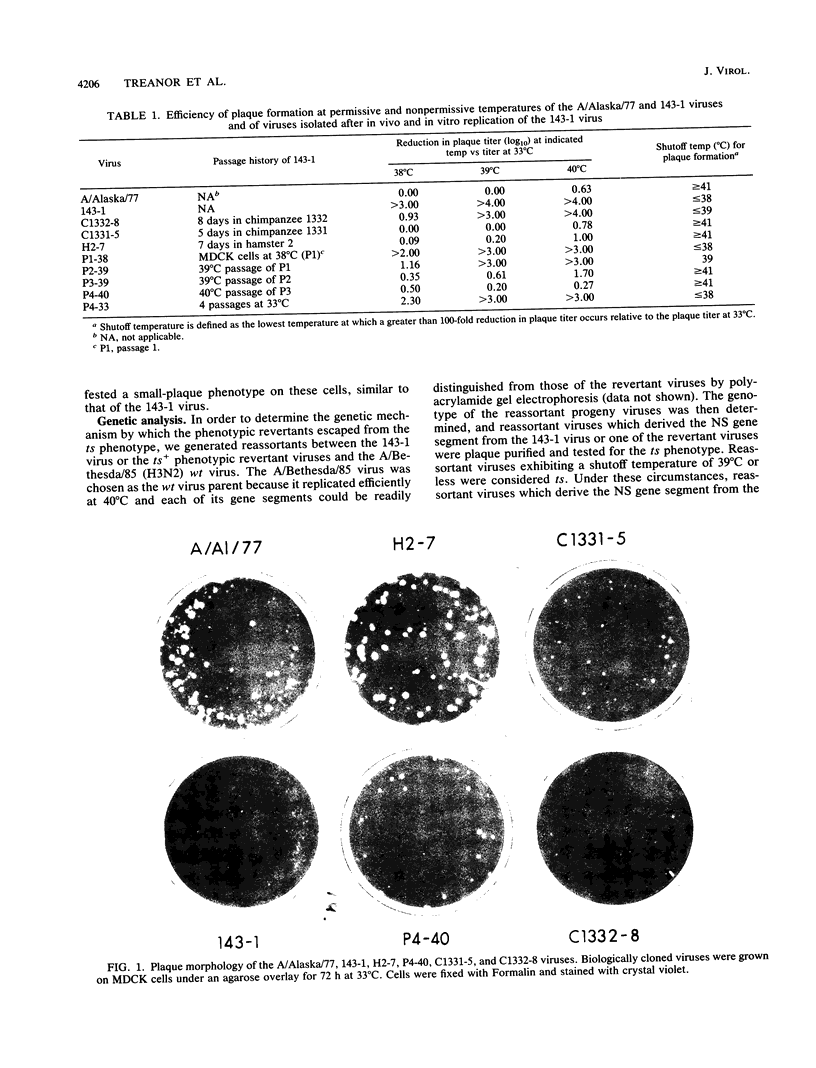
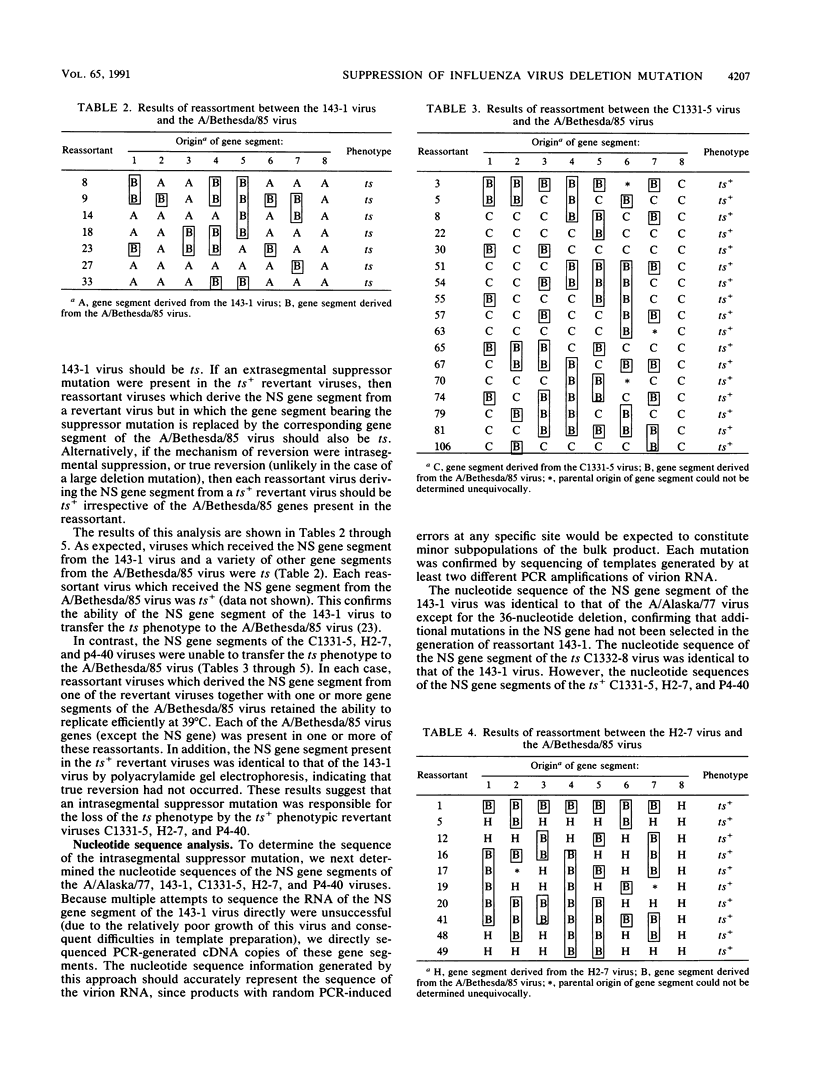
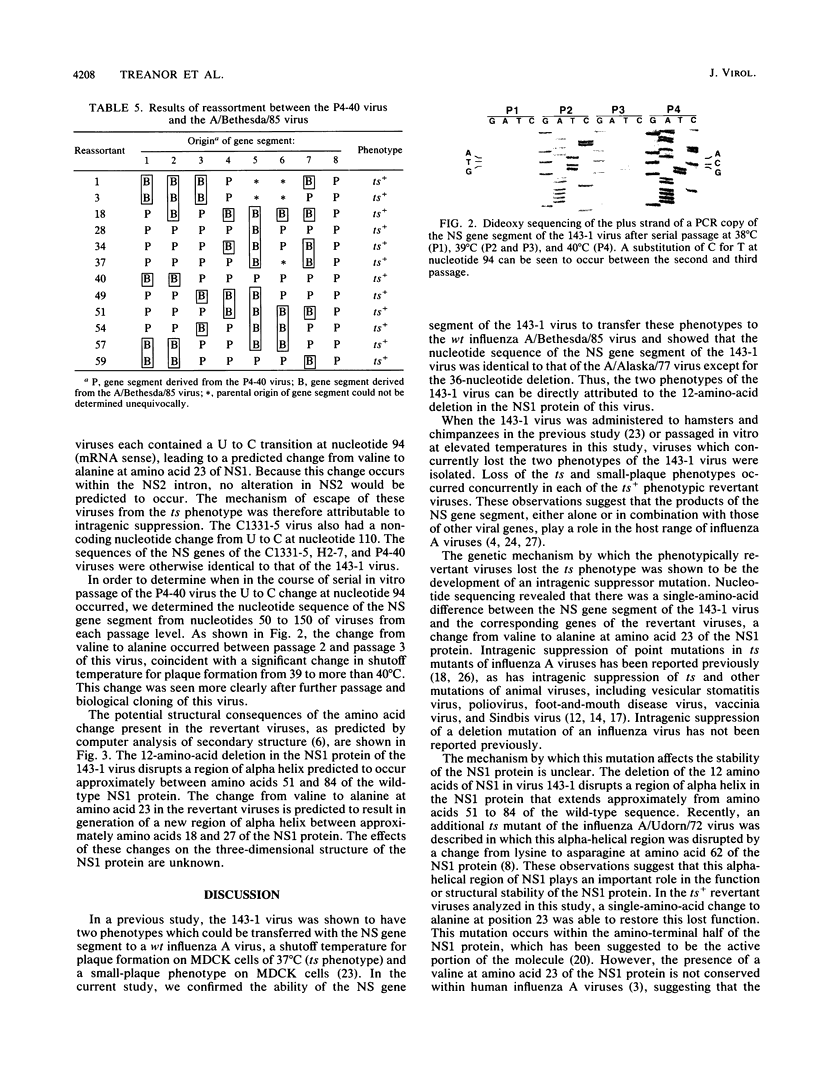
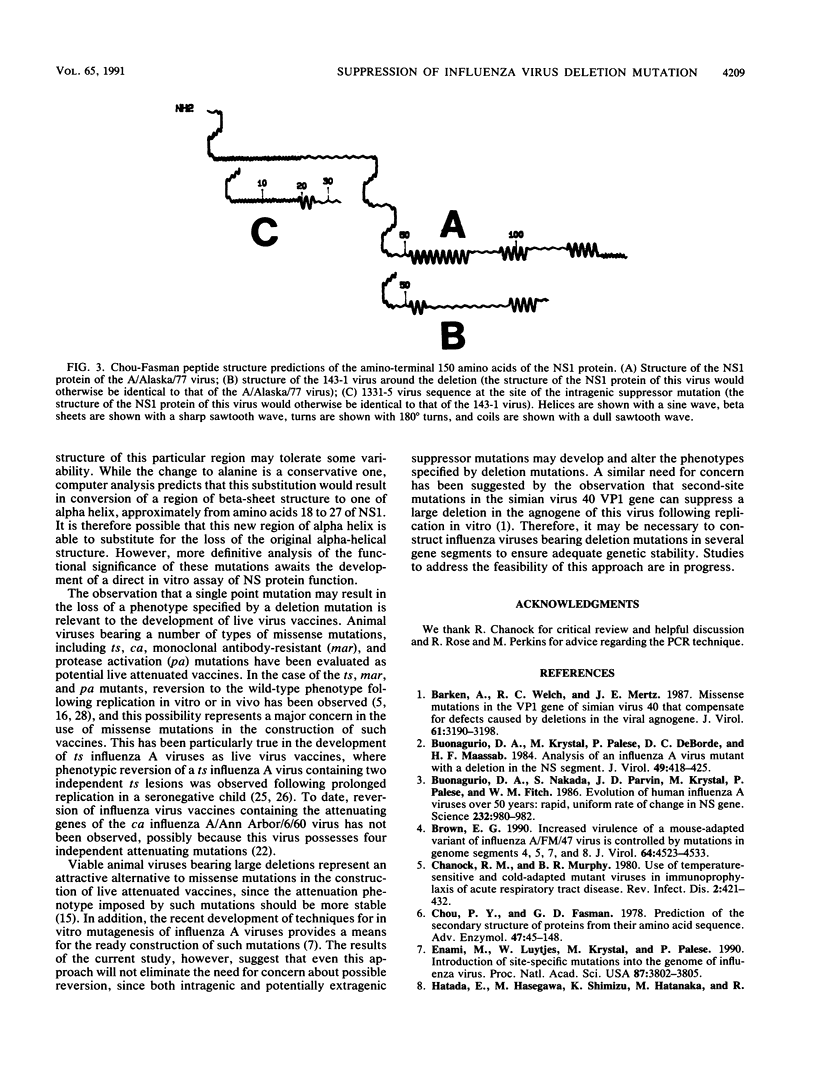
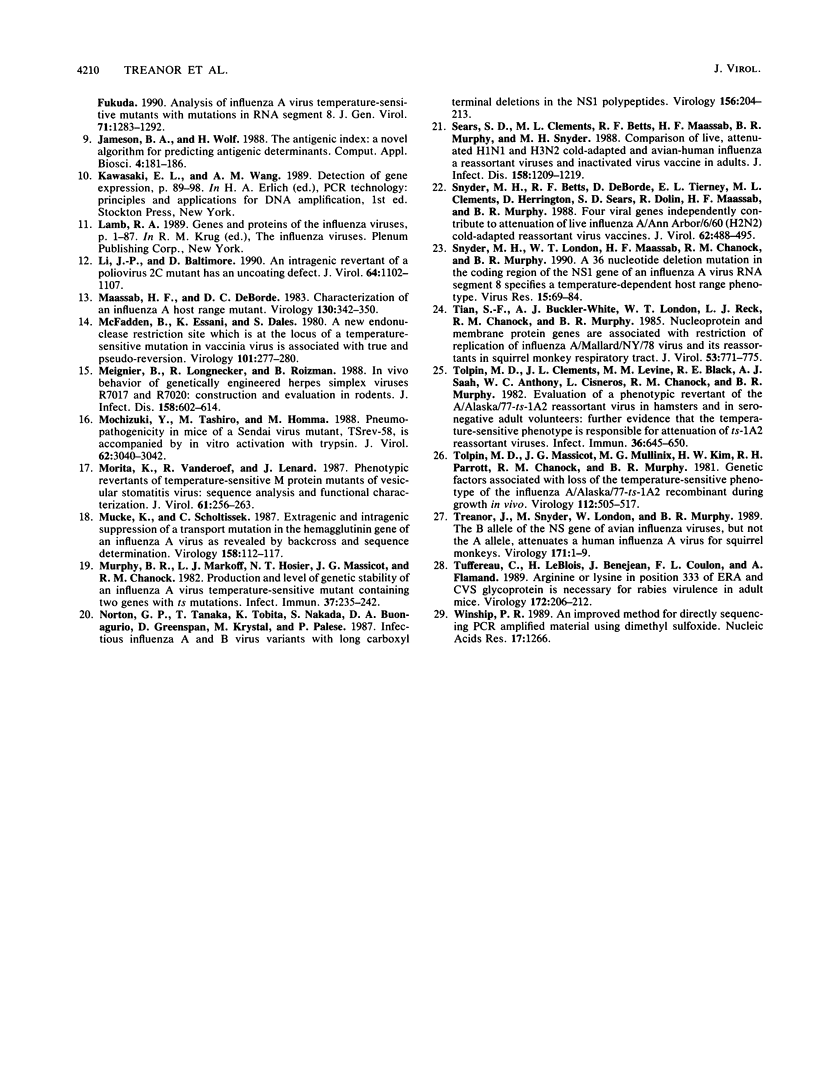
Images in this article
Selected References
These references are in PubMed. This may not be the complete list of references from this article.
- Barkan A., Welch R. C., Mertz J. E. Missense mutations in the VP1 gene of simian virus 40 that compensate for defects caused by deletions in the viral agnogene. J Virol. 1987 Oct;61(10):3190–3198. doi: 10.1128/jvi.61.10.3190-3198.1987. [DOI] [PMC free article] [PubMed] [Google Scholar]
- Brown E. G. Increased virulence of a mouse-adapted variant of influenza A/FM/1/47 virus is controlled by mutations in genome segments 4, 5, 7, and 8. J Virol. 1990 Sep;64(9):4523–4533. doi: 10.1128/jvi.64.9.4523-4533.1990. [DOI] [PMC free article] [PubMed] [Google Scholar]
- Buonagurio D. A., Krystal M., Palese P., DeBorde D. C., Maassab H. F. Analysis of an influenza A virus mutant with a deletion in the NS segment. J Virol. 1984 Feb;49(2):418–425. doi: 10.1128/jvi.49.2.418-425.1984. [DOI] [PMC free article] [PubMed] [Google Scholar]
- Buonagurio D. A., Nakada S., Parvin J. D., Krystal M., Palese P., Fitch W. M. Evolution of human influenza A viruses over 50 years: rapid, uniform rate of change in NS gene. Science. 1986 May 23;232(4753):980–982. doi: 10.1126/science.2939560. [DOI] [PubMed] [Google Scholar]
- Chanock R. M., Murphy B. R. Use of temperature-sensitive and cold-adapted mutant viruses in immunoprophylaxis of acute respiratory tract disease. Rev Infect Dis. 1980 May-Jun;2(3):421–432. doi: 10.1093/clinids/2.3.421. [DOI] [PubMed] [Google Scholar]
- Chou P. Y., Fasman G. D. Prediction of the secondary structure of proteins from their amino acid sequence. Adv Enzymol Relat Areas Mol Biol. 1978;47:45–148. doi: 10.1002/9780470122921.ch2. [DOI] [PubMed] [Google Scholar]
- Enami M., Luytjes W., Krystal M., Palese P. Introduction of site-specific mutations into the genome of influenza virus. Proc Natl Acad Sci U S A. 1990 May;87(10):3802–3805. doi: 10.1073/pnas.87.10.3802. [DOI] [PMC free article] [PubMed] [Google Scholar]
- Hatada E., Hasegawa M., Shimizu K., Hatanaka M., Fukuda R. Analysis of influenza A virus temperature-sensitive mutants with mutations in RNA segment 8. J Gen Virol. 1990 Jun;71(Pt 6):1283–1292. doi: 10.1099/0022-1317-71-6-1283. [DOI] [PubMed] [Google Scholar]
- Jameson B. A., Wolf H. The antigenic index: a novel algorithm for predicting antigenic determinants. Comput Appl Biosci. 1988 Mar;4(1):181–186. doi: 10.1093/bioinformatics/4.1.181. [DOI] [PubMed] [Google Scholar]
- Li J. P., Baltimore D. An intragenic revertant of a poliovirus 2C mutant has an uncoating defect. J Virol. 1990 Mar;64(3):1102–1107. doi: 10.1128/jvi.64.3.1102-1107.1990. [DOI] [PMC free article] [PubMed] [Google Scholar]
- Maassab H. F., DeBorde D. C. Characterization of an influenza A host range mutant. Virology. 1983 Oct 30;130(2):342–350. doi: 10.1016/0042-6822(83)90088-0. [DOI] [PubMed] [Google Scholar]
- McFadden G., Essani K., Dales S. A new endonuclease restriction site which is at the locus of a temperature-sensitive mutation in vaccinia virus is associated with true and pseudoreversion. Virology. 1980 Feb;101(1):277–280. doi: 10.1016/0042-6822(80)90503-6. [DOI] [PubMed] [Google Scholar]
- Meignier B., Longnecker R., Roizman B. In vivo behavior of genetically engineered herpes simplex viruses R7017 and R7020: construction and evaluation in rodents. J Infect Dis. 1988 Sep;158(3):602–614. doi: 10.1093/infdis/158.3.602. [DOI] [PubMed] [Google Scholar]
- Mochizuki Y., Tashiro M., Homma M. Pneumopathogenicity in mice of a Sendai virus mutant, TSrev-58, is accompanied by in vitro activation with trypsin. J Virol. 1988 Aug;62(8):3040–3042. doi: 10.1128/jvi.62.8.3040-3042.1988. [DOI] [PMC free article] [PubMed] [Google Scholar]
- Morita K., Vanderoef R., Lenard J. Phenotypic revertants of temperature-sensitive M protein mutants of vesicular stomatitis virus: sequence analysis and functional characterization. J Virol. 1987 Feb;61(2):256–263. doi: 10.1128/jvi.61.2.256-263.1987. [DOI] [PMC free article] [PubMed] [Google Scholar]
- Murphy B. R., Markoff L. J., Hosier N. T., Massicot J. G., Chanock R. M. Production and level of genetic stability of an influenza A virus temperature-sensitive mutant containing two genes with ts mutations. Infect Immun. 1982 Jul;37(1):235–242. doi: 10.1128/iai.37.1.235-242.1982. [DOI] [PMC free article] [PubMed] [Google Scholar]
- Mücke K., Scholtissek C. Extragenic and intragenic suppression of a transport mutation in the hemagglutinin gene of an influenza A virus as revealed by backcross and sequence determination. Virology. 1987 May;158(1):112–117. doi: 10.1016/0042-6822(87)90243-1. [DOI] [PubMed] [Google Scholar]
- Norton G. P., Tanaka T., Tobita K., Nakada S., Buonagurio D. A., Greenspan D., Krystal M., Palese P. Infectious influenza A and B virus variants with long carboxyl terminal deletions in the NS1 polypeptides. Virology. 1987 Feb;156(2):204–213. doi: 10.1016/0042-6822(87)90399-0. [DOI] [PubMed] [Google Scholar]
- Sears S. D., Clements M. L., Betts R. F., Maassab H. F., Murphy B. R., Snyder M. H. Comparison of live, attenuated H1N1 and H3N2 cold-adapted and avian-human influenza A reassortant viruses and inactivated virus vaccine in adults. J Infect Dis. 1988 Dec;158(6):1209–1219. doi: 10.1093/infdis/158.6.1209. [DOI] [PubMed] [Google Scholar]
- Snyder M. H., Betts R. F., DeBorde D., Tierney E. L., Clements M. L., Herrington D., Sears S. D., Dolin R., Maassab H. F., Murphy B. R. Four viral genes independently contribute to attenuation of live influenza A/Ann Arbor/6/60 (H2N2) cold-adapted reassortant virus vaccines. J Virol. 1988 Feb;62(2):488–495. doi: 10.1128/jvi.62.2.488-495.1988. [DOI] [PMC free article] [PubMed] [Google Scholar]
- Snyder M. H., London W. T., Maassab H. F., Chanock R. M., Murphy B. R. A 36 nucleotide deletion mutation in the coding region of the NS1 gene of an influenza A virus RNA segment 8 specifies a temperature-dependent host range phenotype. Virus Res. 1990 Jan;15(1):69–83. doi: 10.1016/0168-1702(90)90014-3. [DOI] [PubMed] [Google Scholar]
- Tian S. F., Buckler-White A. J., London W. T., Reck L. J., Chanock R. M., Murphy B. R. Nucleoprotein and membrane protein genes are associated with restriction of replication of influenza A/Mallard/NY/78 virus and its reassortants in squirrel monkey respiratory tract. J Virol. 1985 Mar;53(3):771–775. doi: 10.1128/jvi.53.3.771-775.1985. [DOI] [PMC free article] [PubMed] [Google Scholar]
- Tolpin M. D., Clements M. L., Levine M. M., Black R. E., Saah A. J., Anthony W. C., Cisneros L., Chanock R. M., Murphy B. R. Evaluation of a phenotypic revertant of the A/Alaska/77-ts-1A2 reassortant virus in hamsters and in seronegative adult volunteers: further evidence that the temperature-sensitive phenotype is responsible for attenuation of ts-1A2 reassortant viruses. Infect Immun. 1982 May;36(2):645–650. doi: 10.1128/iai.36.2.645-650.1982. [DOI] [PMC free article] [PubMed] [Google Scholar]
- Tolpin M. D., Massicot J. G., Mullinix M. G., Kim H. W., Parrott R. H., Chanock R. M., Murphy B. R. Genetic factors associated with loss of the temperature-sensitive phenotype of the influenza A/Alaska/77-ts-1A2 recombinant during growth in vivo. Virology. 1981 Jul 30;112(2):505–517. doi: 10.1016/0042-6822(81)90298-1. [DOI] [PubMed] [Google Scholar]
- Treanor J. J., Snyder M. H., London W. T., Murphy B. R. The B allele of the NS gene of avian influenza viruses, but not the A allele, attenuates a human influenza A virus for squirrel monkeys. Virology. 1989 Jul;171(1):1–9. doi: 10.1016/0042-6822(89)90504-7. [DOI] [PubMed] [Google Scholar]
- Tuffereau C., Leblois H., Bénéjean J., Coulon P., Lafay F., Flamand A. Arginine or lysine in position 333 of ERA and CVS glycoprotein is necessary for rabies virulence in adult mice. Virology. 1989 Sep;172(1):206–212. doi: 10.1016/0042-6822(89)90122-0. [DOI] [PubMed] [Google Scholar]
- Winship P. R. An improved method for directly sequencing PCR amplified material using dimethyl sulphoxide. Nucleic Acids Res. 1989 Feb 11;17(3):1266–1266. doi: 10.1093/nar/17.3.1266. [DOI] [PMC free article] [PubMed] [Google Scholar]




